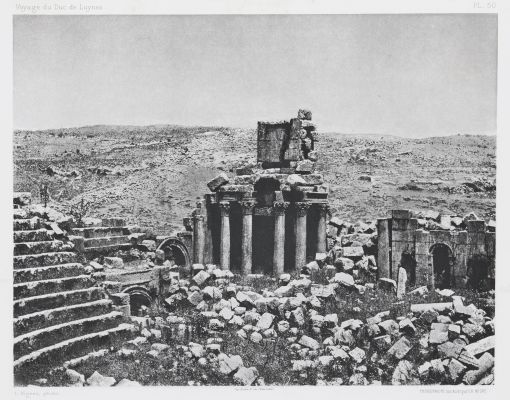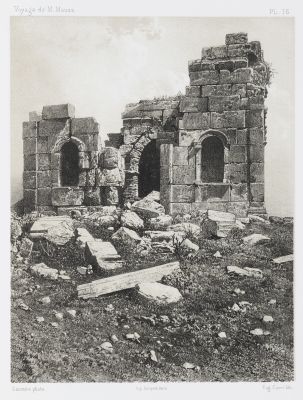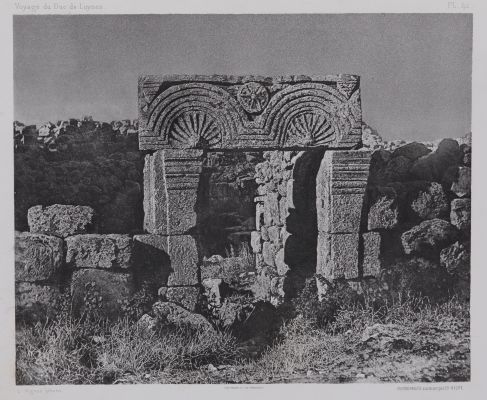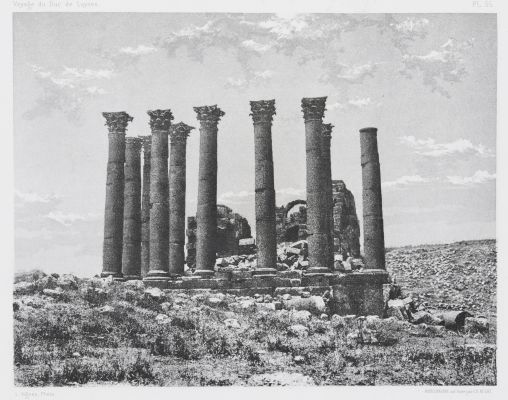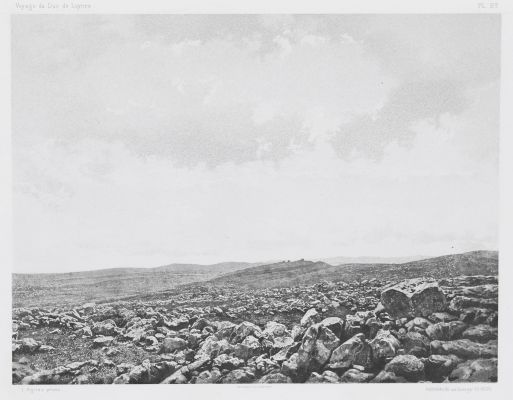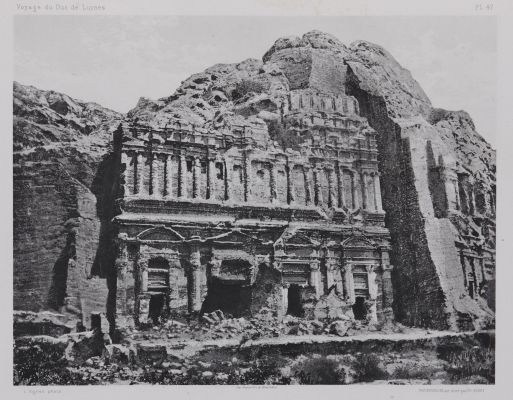
Title
PL. 7 Sidon: Chateau de St LouisArtist
Vignes, Louis (French, 1831-1896)Publication
Voyage D'Exploration a La Mer MorteDate
1865-1868 plate (1864 negative, 1871-1876 print)Process
PhotogravureAtelier
Charles NègreImage Size
27 x 20 cm
An incunabula of photo-mechanically illustrated books and among the earliest published photographs of Jordan and the Dead Sea basin. The book … remains one of the finest photomechanically printed books of the era. [1]
This rare book is closely connected with an important event in history of photogravure.
In 1856, Honoré d’Albert, Duc de Luynes, archaeologist, scientist and connoisseur, initiated a competition in conjunction with the Société Française de Photographie (SFP) to find the best method of photomechanical reproduction. The major prize of 7,000 francs was awarded 11 years later to Alphonse Louis Poitevin for his method of photolithography. Poitevin’s method had been shortlisted for the award 1856, but declaring a winner was delayed for years because the judges considered none of the processes entered to be perfect and postponed their decision until it was clear that nothing better was imminent. Poitevin became victor by default.
Meanwhile, the competition’s instigator, the Duc de Luynes, had led a geological expedition to the Dead Sea in 1864 and, upon his return, proposed to publish the pictures taken by the party’s photographer, Louis Vignes. But rather than choosing the winner of his competition to make the photomechanical reproductions, the Duc selected Charles Nègre, who had also been shortlisted for the prize. Nègre had developed a photogravure method that produced beautiful prints but was even more complicated and unwieldy in practice than Poitevin’s method- an impediment that clashed with the competition’s aim of finding the most practicable system.
Albumen prints made from Vignes’ original negatives from the expedition show the myriad of flaws that Luynes had to overcome. They were taken in harsh conditions – poorly exposed and flawed. Overcoming these issues, Nègre was able to open up the shadows and fill them with light, detail and space. “Undoubtedly the main reason the Duke chose Nègre to perform this task lay in the quality of the prints Nègre was capable of producing … for he had achieved a control over his process which resulted in prints of rich tones, fine detail, transparency and effect" [2]. For the photogravures, Nègre created cloud formations through a combination of acid resistant varnish brushed on to the plate, powdered resin distributed over the plate’s surface, and successive submersions of the plate in an acid bath. The final results demonstrate Nègre’s technical and visual sophistication with platemaking. Not only was Nègre capable of mending Vignes’ negatives, His photogravures transformed the photographs into evocative images of great poetry ‘Ultimately foiled by his own artistry, Nègre was not awarded the Duke de Luynes’ prize … because none of the judges believed that anyone but Nègre himself could produce such beautiful photo-engraved plates.’
Luynes died before the work would be published, leaving the task to his son and Le Comte de Vogëé. Perhaps to save expense, they commissioned Eugene Ciceri, who had acquired fame as a lithographist around 1865, to reproduce the Sauvaire photographs lithographically. Without denying his artistic talent, it must be acknowledged that the quality of his results is inferior by far to that obtained by Nègre.
While the archaeological and scientific observations within the text were groundbreaking at the time, the work is today best appreciated for its stunning atlas of photogravure plates. To the small but vitally important field of nineteenth-century photomechanical process, Nègre brought not only technical expertise but also the eye of a master photographer and painter. Quite possibly de Luynes had expected Nègre to win the prize or at least he clearly favored the photogravure print for it’s beauty, permanence and tonal nuance. Voyage d’exploration: la Mer Morte remains one of the finest photo-mechanically printed books of the era. [3]
For more information on this project see highlight essay: https://photogravure.com/highlights/vinges-sauvaire-placet-negre-and-the-duke/
Reproduced / Exhibited
Hellman, Karen, Sylvie Aubenas, Sarah Freeman, Anne . Mondenard, Karlyn Olvido, and Paul-Louis Roubert. Real/ideal: Photography in Mid-Nineteenth-Century France : [exhibition, Los Angeles – Getty Center (j. Paul Getty Museum), August 30 – November 27, 2016]. Los Angeles: J. Paul Getty Museum, 2016. fig.144.
References
[1] Parr, Martin, and Gerry Badger. The Photobook: A History. London: Phaidon, 2014. p. 33
[2] Borcoman, James. Charles Negre. Ottawa: Galerie nationale du Canada, 1976. Fig. 200.
[3] Parr, Martin, and Gerry Badger. The Photobook: A History. London: Phaidon, 2014. p. 33
Heilbrun, Françoise. Charles Nègre, Photographe: 1820-1880 ; Arles, Musée Réattu, 5.7. – 17.8.1980. Paris: Éd. des musées nationaux, 1980. no. 152.
Frizot, Michael. New History of Photography. Place of publication not identified: Pajerski, 1999. Print P. 230
D’encre Et De Charbon: Le Concours Photographique Du Duc De Luynes 1856-1867. Paris: BibliotheÌque nationale, 1994 No. 4
Hellman, Karen, Sylvie Aubenas, Sarah Freeman, Anne . Mondenard, Karlyn Olvido, and Paul-Louis Roubert. Real/ideal: Photography in Mid-Nineteenth-Century France : [exhibition, Los Angeles – Getty Center (j. Paul Getty Museum), August 30 – November 27, 2016]. Los Angeles: J. Paul Getty Museum, 2016. fig.144.
Hanson, David A. Checklist of Photomechanical Processes and Printing, 1825-1910. , 2017. p. 95.
Foster, Sheila J, Manfred Heiting, and Rachel Stuhlman. Imagining Paradise: The Richard and Ronay Menschel Library at George Eastman House, Rochester. Göttingen: Steidl, 2007 p. 105
Parr, Martin, and Gerry Badger. The Photobook: A History. London: Phaidon, 2014. p. 33
Jammes André and Eugenia Parry. 1983. The Art of French Calotype : With a Critical Dictionary of Photographers 1845-1870. Princeton N.J: Princeton University Press. P 222
Goldschmidt Lucien Weston J Naef and Grolier Club. 1980. The Truthful Lens : A Survey of the Photographically Illustrated Book 1844-1914. 1st ed. New York: Grolier Club p. 109
Foliot, Philippe. "Louis Vignes and Henry Sauvaire, Photographers on the Expeditions of the Duc De Luynes." History of Photography. 14.3




